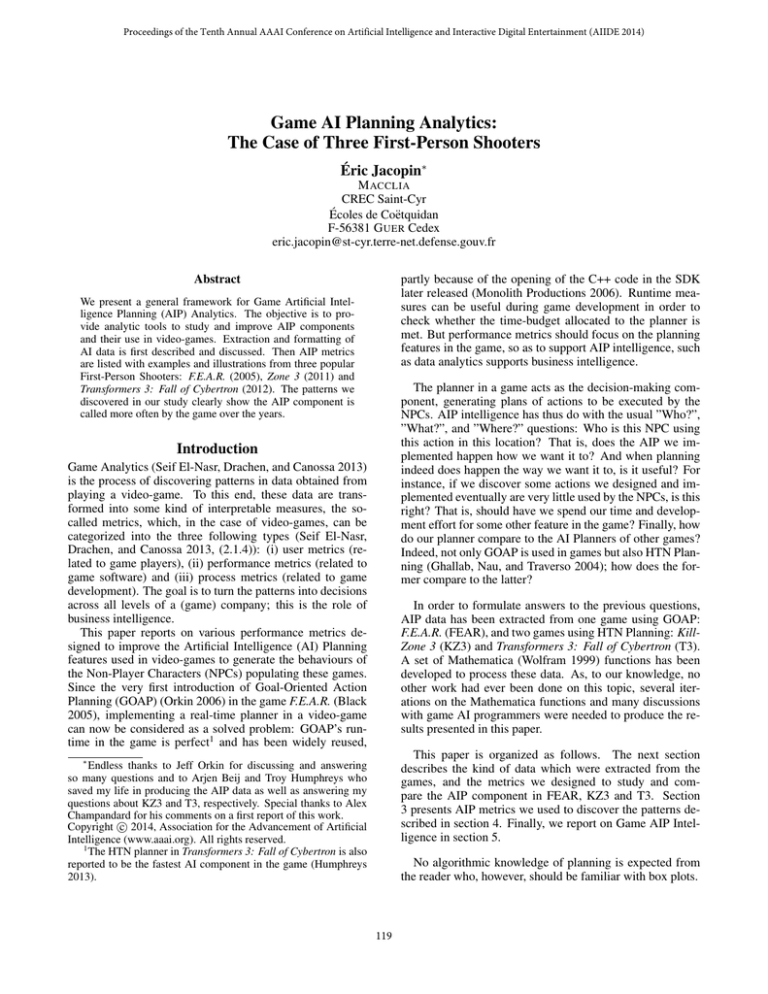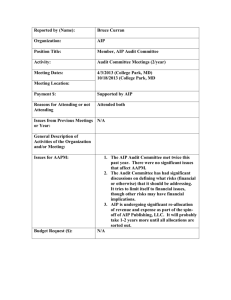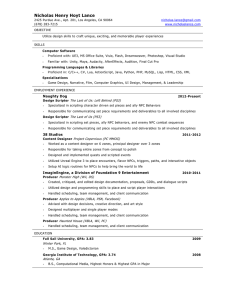
Proceedings of the Tenth Annual AAAI Conference on Artificial Intelligence and Interactive Digital Entertainment (AIIDE 2014)
Game AI Planning Analytics:
The Case of Three First-Person Shooters
Éric Jacopin∗
M ACCLIA
CREC Saint-Cyr
Écoles de Coëtquidan
F-56381 G UER Cedex
eric.jacopin@st-cyr.terre-net.defense.gouv.fr
Abstract
partly because of the opening of the C++ code in the SDK
later released (Monolith Productions 2006). Runtime measures can be useful during game development in order to
check whether the time-budget allocated to the planner is
met. But performance metrics should focus on the planning
features in the game, so as to support AIP intelligence, such
as data analytics supports business intelligence.
We present a general framework for Game Artificial Intelligence Planning (AIP) Analytics. The objective is to provide analytic tools to study and improve AIP components
and their use in video-games. Extraction and formatting of
AI data is first described and discussed. Then AIP metrics
are listed with examples and illustrations from three popular
First-Person Shooters: F.E.A.R. (2005), Zone 3 (2011) and
Transformers 3: Fall of Cybertron (2012). The patterns we
discovered in our study clearly show the AIP component is
called more often by the game over the years.
The planner in a game acts as the decision-making component, generating plans of actions to be executed by the
NPCs. AIP intelligence has thus do with the usual ”Who?”,
”What?”, and ”Where?” questions: Who is this NPC using
this action in this location? That is, does the AIP we implemented happen how we want it to? And when planning
indeed does happen the way we want it to, is it useful? For
instance, if we discover some actions we designed and implemented eventually are very little used by the NPCs, is this
right? That is, should have we spend our time and development effort for some other feature in the game? Finally, how
do our planner compare to the AI Planners of other games?
Indeed, not only GOAP is used in games but also HTN Planning (Ghallab, Nau, and Traverso 2004); how does the former compare to the latter?
Introduction
Game Analytics (Seif El-Nasr, Drachen, and Canossa 2013)
is the process of discovering patterns in data obtained from
playing a video-game. To this end, these data are transformed into some kind of interpretable measures, the socalled metrics, which, in the case of video-games, can be
categorized into the three following types (Seif El-Nasr,
Drachen, and Canossa 2013, (2.1.4)): (i) user metrics (related to game players), (ii) performance metrics (related to
game software) and (iii) process metrics (related to game
development). The goal is to turn the patterns into decisions
across all levels of a (game) company; this is the role of
business intelligence.
This paper reports on various performance metrics designed to improve the Artificial Intelligence (AI) Planning
features used in video-games to generate the behaviours of
the Non-Player Characters (NPCs) populating these games.
Since the very first introduction of Goal-Oriented Action
Planning (GOAP) (Orkin 2006) in the game F.E.A.R. (Black
2005), implementing a real-time planner in a video-game
can now be considered as a solved problem: GOAP’s runtime in the game is perfect1 and has been widely reused,
In order to formulate answers to the previous questions,
AIP data has been extracted from one game using GOAP:
F.E.A.R. (FEAR), and two games using HTN Planning: KillZone 3 (KZ3) and Transformers 3: Fall of Cybertron (T3).
A set of Mathematica (Wolfram 1999) functions has been
developed to process these data. As, to our knowledge, no
other work had ever been done on this topic, several iterations on the Mathematica functions and many discussions
with game AI programmers were needed to produce the results presented in this paper.
This paper is organized as follows. The next section
describes the kind of data which were extracted from the
games, and the metrics we designed to study and compare the AIP component in FEAR, KZ3 and T3. Section
3 presents AIP metrics we used to discover the patterns described in section 4. Finally, we report on Game AIP Intelligence in section 5.
∗
Endless thanks to Jeff Orkin for discussing and answering
so many questions and to Arjen Beij and Troy Humphreys who
saved my life in producing the AIP data as well as answering my
questions about KZ3 and T3, respectively. Special thanks to Alex
Champandard for his comments on a first report of this work.
c 2014, Association for the Advancement of Artificial
Copyright Intelligence (www.aaai.org). All rights reserved.
1
The HTN planner in Transformers 3: Fall of Cybertron is also
reported to be the fastest AI component in the game (Humphreys
2013).
No algorithmic knowledge of planning is expected from
the reader who, however, should be familiar with box plots.
119
unexpected lexical parsing4 was eventually needed to format
the HTN Planning data logged in files; Troy Humphreys,
from High Moons Studio, produced the data when playing 4
levels of T3 for a total of 35 minutes and 30 seconds.
We end with some remarks about the AIP data:
AI Planning data
The AIP data production chain is the following: the game
code is instrumented to produce AIP in-game data (timestamp, NPC name, actions and their parameters, plan length,
. . . ) which is logged to a file while playing the game; specific tokens may be added to that file so as to facilitate the
next parsing and rewriting step to suit the input format of
your preferred analytic tools.
This section describes the format of the AIP data which
are extracted from the data logged in files while playing the
games.
We began this study with FEAR and modified the freely
available SDK source code so as to record, in a log file, each
plan generated by the planner for a given NPC, together with
a time stamp so as to know when this plan was generated.
Playing FEAR, we adapted the planning data as we began
to better understand what was needed. That is, the AI Planner must be given a chance to produce meaningful plans:
we learnt not to rush in a room and immediately kill all the
NPCs. As a plan in FEAR is a totally ordered set of actions, we listed the actions of a plan in their order of appearance. The following format was designed for an easy input
to Mathematica and was eventually used for KZ3 and T3:
• Time Stamp We used milliseconds in FEAR and the AIP
component is so fast that the time stamps of a (very) few
series of consecutive plans have the same numeric value.
We thus advise a counter with a higher resolution: the
KZ3 counter has 79,800,000 ticks per seconds and the
T3 counter has 10,000 ticks per seconds.
• Initial situation and Goal were never recorded. Goal
would help detecting whether re-planning happens; that
is, several consecutive plans are generated for the same
NPC, but is it for different goals or for the same one?
The initial situation results from sensing: when the sensing is wrong, the generated plan can be wrong, although
rightly achieving the goal we want; for instance the NPC
can use a weapon not adequate to the situation. Consequently, recording the initial situation can be useful for
sensor tuning, but also for an off-line study of alternative
plans: what plans could be generated from this initial situation?
• Level identifier can be useful when processing multiple
data files; for instance, it may happen the same NPC name
appears across several data files: should we distinguish
these occurrences?
{359000, noname1817, AttackFromCover, {kWSK[TargetIsDead], 1}, 1}
359000 is a millisecond time stamp since the beginning of the playing session.
The plan is for the
NPC named noname1817 and is of length 1 (the
last piece of information); the (only) action identifier
is AttackFromCover, which means that, hopefully,
noname1817’s TargetIsDead after this action is executed.
As simple as it may look, getting, directly from the game,
the AIP data in the exact format above for any game should
be considered as awkward due to various implementations
schemes and the features of the languages used to implement
the AI Planner2 . It is probably quicker and easier to first
extract in-game data in the easiest way, and then parse and
rewrite these data to suit your analytic tools. Consequently,
the raw data extracted during a playing session (both KZ3
and T3), was specifically parsed and rewritten3 in the above
format.
We finished FEAR several times and eventually sampled
17 session files (about 3 hours and 45 minutes) between level
2 (Infiltration) and level 11 (Sayonara, Sucker) (see (Black
2005) for details about these levels).
The data from KZ3 was produced by Arjen Beij from
Guerilla Games, when playing (during 13 minutes and 2
seconds) the first two sections of the Scrapyard level of
KZ3 (Hassan et al. 2011).
The HTN Planner of T3 is written in Kismet and some
The next section presents the measures which we performed on the AIP data.
AI Planning Metrics
AIP Metrics are measures of the kind of planning the AI Engine provides to players when they interact with the game; in
that sense, the AI Engine assists the player to enjoy a playing experience. The purpose of these metrics is to help the
development team discover/understand/confirm the kind of
planning which happens in the game.
Active Concurrent NPCs Game AIP is not as continuous
as a web service: the Peak Concurrent Users metric (Seif
El-Nasr, Drachen, and Canossa 2013, (4.4.3)) is less crucial
here but nevertheless reports on the AIP load: how often
shall the planner switch from one NPC to another? Should
the planner plan for so many/few NPCs? The answer is the
first step into planning culling. Figure 1 shows the whisker
boxes for the number of active concurrent NPCs (an NPC is
active in-between its first and last call for planning); on average, FEAR and T3 are similar but the planning in FEAR
handles up to 15 NPCs (cf. next metric). As in Figure 1
the planning in KZ3 appears to handle more NPCs, Figure 2
shows how these NPCs flow along the playing session, forcing the player to manage several NPCs at a time (5 on average and up to 10 from about 350 to 380 seconds).
Number of Plans per NPC We are looking for maximum
and minimum values as another measure of the planning
2
Let aside the problem of partially ordered set of actions which
this format cannot represent; the HTN Planning component of KZ3
and T3 produce, at the more concrete level, totally ordered plans.
3
For instance, Mathematica uses ” ” and ”:” as macro-characters for typing and assigning default values, respectively: these
characters (and others) had to be discarded.
4
For instance, the same action identifier had slightly different
spelling in a log file: ” ” could appear in front of the action identifier and the case of a few characters could change.
120
Figure 1: An NPC is active between its first and last call
for planning; on the y-axis is the number of active NPCs,
regardless of their simultaneous (i.e. same frame) call for
planning, as this also depends on the AI update rate of the
game; for instance, the AI in KZ3 is updated every 200 milliseconds (van der Beek 2007).
Figure 3: The maximum values, removed from this graphic for readability reasons, are the following: 393 plans
generated for NPC Rat02 in FEAR (left), 463 plans
for NPC Rico in KZ3 (center), and 1985 for NPC
AICTLaserbeak in T3 (right).
Figure 4: Plan length (number of actions in a plan) on the xaxis; for example, about 38% of the plans logged in the T3
session files are of length 3. The first AIP pattern here is that
(al)most (all) of GOAP plans are short and HTN planning
produces the longest plans; the second is that, the longest
plans are for snipers (KZ3 and T3) and patrolling purposes
(FEAR), and for the three games, the shortest plans are for
turrets, drones and animals.
Figure 2: The flow of NPCs for a playing session; the x-axis
is the time (seconds) and y-axis represents NPCs as they
appear in the game, calling for planning: there is a dot for
each plan generated at some point in time for a given NPC.
This casting is typical of the three games: successive waves
of enemies, a buddy/partner NPC sticking to you most of
the time (Rico in KZ3, at y = 4), and some very similar
behaviours (here the drones, for instance at the beginning
of the level, but also the two Ship Turrets at y = 39 and
y = 40). Colours are only made to distinguish between
lines of dots.
whether this result has to do with the AI update rate (200
milliseconds (van der Beek 2007)) of KZ3: the number of
Concurrent Active NPCs metrics shows KZ3 handles more
NPCs on average than the other two games. But the 75%
quartile value of the planning speed is 0.8 for KZ3 and 2.6
for T3, that is more than 3 times, whereas the 75% quartile
value of the number of Concurrent Active NPCs is 7 NPCs
for KZ3 and 5 for T3: for 75% of the values, planning thus
is three times faster in T3 than in KZ3 although T3 handles
only 57 (71%) less NPCs. The question raised here is where
the planning speed should go? More plans per NPCs or else
more NPCs on screen?
Plan Lengths We can expect that the longer the plan the
longer the search for it. This also why, probably, GOAP’s
plans are the shortest (cf. Figure 4) as GOAP implements a
classical search procedure in a space of states; indeed, the
HTN Planning components of both KZ3 and T3 allows for
several actions to be included at once in a solution plan, thus
eventually generating longer plans. Note that for these two
games, longest plans are generated for snipers and for the
three games, shorter plans are built for animals, drones and
load (cf. Figure 3). For instance, is it normal that 1985 plans
are generated for T3’s AICTLaserbeak? Yes it is; and so
it is for the 463 plans of the player’s mate Rico in KZ3.
But the 393 plans for the Rat02 of FEAR are questionable:
indeed, the planner keeps generating plans for Rat02 far after the player left it in one of FEAR’s freaky tunnels; this is
why FEAR handles up to 15 NPCs (cf. Previous metric). On
the other bound of the range, there are NPCs needing only
very few plans: do they worth it? Maximum and minimum
values are the second step to planning culling.
Planning Speed is our final measure of the use of the AIP
resource. This value is a function of time on the contrary
of the two previous metrics. We define the speed of planning per NPC as the number of plans divided by the duration
(in seconds) where plans were generated for a given NPC.
Figure 6 shows planning has been going faster, first from
FEAR to KZ3 and then from KZ3 to T3. We may wonder
121
turrets.
Actions (numbers, frequency, category, and usage) There
are 55 actions logged in the session files from FEAR, 44
and 137 in the session files of KZ3 and T3, respectively.
We can expect that not all the available actions have been
recorded during these sessions. As each game is a First
Person-Shooter, each logged action roughly fits into one
of the following category: defensive (lowering danger), offensive (attacking the player), and intermediate (patrolling,
surveillance and animation purposes). The following table
gives the number of actions of each category for the three
games:
FEAR
KZ3
T3
Defensive
11
5
18
Offensive
16
6
12
Figure 5: x-axis represents the action usage (cf. Figure 8)
and y-axis is the action cost; the 55 (red) dots of this graphic
represent the 55 actions logged in the FEAR sessions. We
can observe that despite (relatively) low costs for the two
highest action usage, there is no clear influence of the action
cost over the action usage.
Intermediate
28
33
107
Distinguishing between offensive and defensive actions
may be controversial. But despite mistakes when categorizing fighting actions, the number of actions designed for
fighting purposes is less than the number of non-fighting actions (about a third for both KZ3 and T3) although we here
deal with First Person-Shooters.
Figure 8 presents how many times actions are used. Despite a huge variation in the total number of action occurrences, the highest action occurrence is about the same
for the three games (about 2400); for FEAR and KZ3 this
”highest” action has to do with the game engine mechanics
whereas it is a movement action (FlyTo) for T3. But the
noticeable result here is that half of the available actions are
poorly used. Several actions occur only 1 or 2 times in all
the sessions and it looks reasonable to wonder whether they
should be implemented at all. A final remark, illustrated by
Figure 5: action costs used as search heuristics in GOAP do
not affect the number of occurrences of actions when playing FEAR.
Planning Frequency as a Function of Time How often is
the AI planner called? That is, what is the time-pressure
on the planning component? Figure 7 shows the planning
frequency in KZ3, both from an absolute and an NPC perspective. Such a graphic is very similar for the three games.
The unexpected result, although this is rarely the case here
(i.e. the frequency is close to 0%), is that some NPC appear
to take their time between two calls to the AI Planner; this is
for instance the case for Ship Turrets in KZ3 (cf. horizontal
lines at y = 39 and y = 40 of Figure 2.
The next section presents four patterns we discovered
from assembling AI Planning data and interpreting metrics.
Figure 6: The y-axis represents the Planning Speed per
NPC, i.e. the number of plans per second per NPC; the maximum planning speed is 8.5 for FEAR (left), 3.4 for KZ3
(center), and 59.9 for T3 (right). The median value roughly
doubles from FEAR to KZ3 and then from KZ3 to T3: AIP
has been going faster since 2005.
whether its hyperbolic shape of Figure 7 is a constant for
First-Person Shooters. Indeed, for the three games we studied, the time pressure is high for small amount of time and
then decreases regularly down to very low frequencies for
long intervals between two calls for the AI Planner: 529.75,
80.52, and 22.19 seconds in FEAR, KZ3, and T3, respectively. Again, there are questions for extreme values of an
hyperbolic curve: When the planning frequency is high and
the plan is the same (e.g. rats in FEAR), is AIP the best
component to achieve the behaviour of this NPC? When the
frequency is very low, is this NPC really needed? In FEAR,
there is also the case of NPC Delta01 which appears in
Level 9 right after a dogfight in a lobby (Black 2005), and
keeps calling the AI Planner at about 2 and 4 seconds for
animation purposes.
Fixed Plans are plans which occur with the same sequence
of actions. KZ3 and T3 use HTN Planning and fixed plans
can be understood as HTNs; thus, it is not so surprising that
we find fixed plans in their session files. But it happens that
the FEAR session files also contain fixed plans. There are,
respectively, 10, 11, and 46 fixed sequences of actions in
AI Planning Patterns
AIP Patterns are combined results from AIP measures. For
instance, the highest action usage for one game is not a pattern; the fact that it is about the same value for the three
games is a pattern for the use of AIP in a First-Person
Shooter. The previous sections suggested a few patterns already, but these can be interpreted as extensions of metrics.
Here are structures built from the interpretation of metrics.
Hyperbolic Planning Frequency Following the Planning
Frequency metric of the previous section, we first ask
122
Figure 8: The y-axis is the number of occurrences of a
given action identifier across all sessions; there are 9781
action occurrences in the FEAR session files, 6371 for
KZ3, and 19187 for T3. The maximum number of occurrences for one action, removed from this graphics for readability reasons, are the following: 2566 (26%) for action
UseSmartObjectNode in FEAR (left), 2355 (37%) for
action RememberActivePlan in KZ3 (center), and 2305
(12%) for action FlyTo in T3 (right); it is remarkable these
maxima are so close. However, we believe the most important values are the median values: 50% of all available
actions occur only at most 22 times in FEAR, 33 times in
KZ3, and 30 times in T3; it is again remarkable these values
are so close, but with such a little use in the game, how many
of these actions really worth the development effort?
Figure 7: The x-axis represents time in milliseconds. How
often is the AI planner called? For instance, the second red
square, starting from the left, tells us the AI Planner is called
every 1.5 seconds about 5% of the time; the second blue
triangle tells us that for a given NPC, the AI Planner is called
every 1.5 seconds about 20% of the time.
FEAR, KZ3, and T3. But most of these fixed plans occur
only once; the following table gathers, from FEAR, KZ3
and T3, in that order, the three fixed plans occurring the
most together with their frequency (6679, 2349, and 8751
plans were logged in the FEAR, KZ3, and T3 session files,
respectively):
Fixed Plan’s sequence of actions
Frequency
{GotoNodeOfType, AttackFromView}
{SurveyArea, GotoTarget, InspectDisturbance}
{GotoNode, UseSmartObjectNode}
13
6679
51
6679
2355
6679
1
87
4
261
115
2349
199
8751
626
8751
1838
8751
{ remember.activeplan, staggerfire}
{ remember.activeplan, lapapeekatentity}
{ remember.activeplan, scanwaypointlistlapa}
{StartStrafing, StrafingIdle}
{Asleep, Idle}
{ChooseNewAttackPoint, FlyTo}
We will not discuss the content of these plans but question their existence: instead of searching for these plans,
shouldn’t we instead put these fixed plans in some hashing
table, indexed by the initial and goal situation? The answer
is a step into the architecture of the AI Engine which can not
only search for plans but also fetch plans.
Pareto principle for Game AIP If we sum 20% of the highest numeric values of the action usage, we get roughly 80%
of the cumulative action usage for all three games: 86%,
80%, and 82% for FEAR, KZ3, and T3, respectively. That
is, 20% of the actions of a First-Person Shooter own 80%
of the occurrences in the session files. The main argument
against this pattern here is that the Pareto principle is valid
when the data set is huge (T3 illustrates Figure 9 because it
has the highest number of action occurrences: 19187). In
this case, the obvious question is again that of the amount
of development effort that should be spent on the remaining 80% of available actions which (only) impact 20% of
the occurrences. In a dual spirit, the 20% actions which are
used the most should be checked and optimized, in particular when their purpose is animation.
In the next section, we gather the questions of this paper
and briefly discuss how answers can be turned into decisions
for Game AIP.
AI Planning Intelligence
Along with the AIP metrics and patterns, we formulated, in
that order, the following questions:
1. How often shall the planner switch from one NPC to another?
2. Should the planner plan for so many/few NPCs?
3. There are NPCs needing only very few plans: do they
worth it?
4. Where should the planning speed go?
5. More plans per NPCs or else more NPCs on screen?
6. How often is the AI planner called?
7. What is the time-pressure on the planning component?
8. Is AIP the best component to achieve the behaviour of this
NPC?
9. When the planning frequency is very low for a given NPC,
is this NPC really needed?
10. Shouldn’t the fixed plans be stored in some hashing table,
indexed by the initial and goal situation?
Answers to these questions can support decisions on the
following topics, reporting to game design and production
during iterations:
• AIP development effort (e.g. questions 3, 4, 5, and 9),
• AIP technical specifications (e.g. questions 6, and 7),
• AI Engine features (e.g. questions 4 – because the AI
update rate might influence the planning speed, 8, and 10).
123
Monolith Productions. 2006. F.E.A.R. public tools.
Orkin, J. 2006. Three States and a Plan: The A.I. of
F.E.A.R. In Proceedings of the Game Developer Conference, 17 pages.
Seif El-Nasr, M.; Drachen, A.; and Canossa, A. 2013. Game
Analytics – Maximazing the Value of Player Data. Springer.
van der Beek, J. 2007. Autonomous squand behaviour in a
virtual game environment. Master’s thesis, Vrije Universiteit
of Amsterdam.
Wolfram, S. 1999. The Mathematica Book. Cambridge
University Press.
Figure 9: The x-axis represents an action percentage in decreasing order of action usage and the y-axis is the cumulative action usage in T3. The purpose here is to answer the
following question: how many actions (in percentage of all
actions occurring in the session files) are needed to reach
a given percentage of action usage? Whereas offensive actions are based on a few highly used actions (2 actions to
reach more than 80% of cumulative usage), there is more diversity in the case of defensive actions (6 actions are needed
to reach about 80% of cumulative usage). The results from
T3 are shown here because this game has the highest number
of action occurrences (19187); 20% of all available actions
in T3 own 82% of the cumulative action usage.
Conclusion
What did we learn about AIP in First-Person Shooters?
We can expect Game AIP to handle several tens of actions
in order to build plans with at most 10 actions and smaller
length on average (1 to 5 actions). For instance, GOAP plans
are rather short (1 or 2 actions) while HTN Planning builds
longer plans (2 to 5 actions); long plans seem dedicated to
specific tasks (patrolling, sniping) while the shortest plans
are for turrets, animals and drones. Moreover, some specific
NPCs and actions use AIP more than others. Rather unexpectedly, most of the AIP time and memory budget in FirstPerson Shooters is not spent into fighting actions but into actions whose purpose is patrolling and animation. Planning
speed is the only metric showing the increase of Game AIP
over the years. Finally, alternatives to AIP should be considered for repetitive actions (i.e. plans of length 1) and fixed
plans (i.e. plans appearing the same sequence of actions).
Perspectives A study of GOAP in its latest implementation would be very valuable. Indeed, what has happened
to GOAP since 2005? Wait. There is Tomb Raider. Crystal
Dynamics, please, get in touch!
References
Black, F. 2005. F.E.A.R. PRIMA Official Game Guide.
PRIMA Games.
Ghallab, M.; Nau, D.; and Traverso, P. 2004. Automated
Planning: Theory and Practice. Morgan Kaufmann.
Hassan, A.; Byrne, B.; Andrews, C.; Niazi, U.; and Murray,
W. 2011. KillZone 3 Official Guide. Future Press.
Humphreys, T. 2013. Exploring HTN planners through examples. In Rabin, S., ed., Game AI Pro. CRC Press. chapter 12, 149–167.
124






